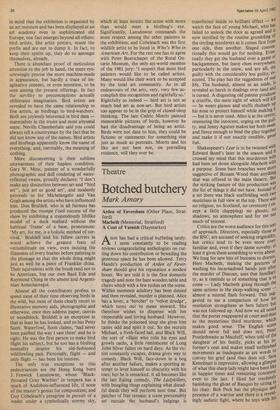Art
Featherweight
John McEwen
you do not have to be Susan Hill to know that rueful owls are once more a-nesting, the black-headed gulls seem all to have slipped while dipping their beaks in the liquid chocolate of the newly ploughed fields, the dawn chorus again swells the chest of the woods. Spring is here, that is the point,-and with it the birds — and with that the 1981 Bird Art Exhibition, 'featur- ing the Contemporary Western World's finest Bird Art' (Natural History Museum till 1 May). The little Leigh Yawkey Wood- son Art Museum in the depths of Wisconsin inaugurated and continues to orchestrate this unique event — the most prestigious annual showing of the work of living bird painters and sculptors — which travels this year courtesy of Gulf Oil, has already been seen at the Scottish Royal Academy and concludes its tour back in America at the Carnegie Museum of Natural History, Pittsburg (7 June to 17 July). Reading the pocket-sized catalogue to the show, bearing
in mind that the exhibition is organised by an art museum and has been displayed at an art academy even in sophisticated old Europe, one fact emerges beyond all others: bird artists, like artist potters, resent the prefix and are out to dump it. In fact, to keep their spirits up, they do so amongst themselves, already.
There is abundant proof of meticulous attention to the job in hand, the more eye- screwingly precise the more machine-made in appearance, but hardly a trace of im- aginative content, or even intention, to be seen among the present offerings. In fact the servility to preconceptions actually obliterates imagination. Bird artists are revealed to have the same relationship to fine artists, as birdbugs to bird-watchers. Both are joylessly interested in bird data materialists in the truest and most abysmal sense. Neville Chamberlain said you could always tell a countryman by the fact that he did not know any of the names. Bird artists and birdbugs apparently know the name of everything, and, inevitably, the meaning of nothing.
More disconcerting is their sublime unawareness of their hapless condition. Gary W, Moss, painter of a wonderfully photographic and dull rendering of water- reflected swans, proudly declares: 'I don't make any distinction between art and "bird art", just art or good art', and modestly proceeds to list Michelangelo and Van Gogh among the artists who have influenced him. Don Briddell, who in all fairness has produced the trompe l'oeil success of the show by exhibiting a stupendously lifelike model of a duck mallard without the habitual 'frame' of a base, pronounces: 'My art, for me, is a holistic method of sur- vival.' Briddell and his fellow carvers in wood achieve the greatest feats of verisimilitude on view, even incising the filaments of every feather before painting in the plumage so that the whole thing might just as well be a piece of Franklin china. Their equivalents with the brush tend not to be American, but our own Basil Ede and Raymond Ching or the absent and Argenti- nian Amuchastegui.
Almost all the contributors profess to spend most of their time observing birds in the wild, but most of them clearly resort to illustrative memory aids, photographic and otherwise, once they address paper, canvas or woodblock. Briddell is an exception in that at least he has looked, and so has Peter Scott. Waterfowl, Scott claims, tad never been painted the way I saw them' and he is right. He was the first person to make bird flight his subject, but he too has a birdbug mentality despite his old-fashioned wildfowling past. Pictorially, flight — and only flight — has been his interest.
The only true exceptions to this pedestrianism are the Hong Kong born J. Fenwick Lansdowne, whose 'Black- throated Gray Warbler' in tempera has a spark of Audubon-influenced life, if none of the master's genius for composition; and Guy Coheleach's peregrine in pursuit of a wader under a symbolically stormy sky,
which at least invests the scene with more than would meet a birdbug's eye. Significantly, Lansdowne commands the most respect among the other painters in the exhibition; and Coheleach was the first wildlife artist to be listed in Who's Who in American Art. For the rest one has to agree with Peter Buerschaper of the Rotal On- tario Museum, the only art-world member of the 1981 jury: 'I suspect that most bird painters would like to be called artists. Many would like their work to be accepted by the total art community. As in all endeavours of the arts, very, very few ac- complish this recognition and rightfully so.' Rightfully so indeed — bird art is not so much bad art as non-art. But bird artists too appear to be in the grip of closed-shop thinking. The late Cedric Morris painted memorable pictures of birds, however he had the disadvantage of being an artist. Birds were not data to him, they could be fictions or statements for something else just as much as portraits. Morris and his like are not here nor, on prevailing evidence, will they ever be.



































 Previous page
Previous page